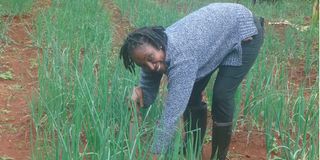Downey mildew in the onion crop

A farmer with her onions in Gatundu. To eradicate Downey mildew in onions, a farmer needs to use a fungicide and practise crop rotation.
Desmond’s onions are in the vegetative stage. He is performing routine management to ensure the crop is healthy.
In this piece, we look at Downey mildew – a fungal disease that affects onions. It typically appears as yellow or pale green spots on leaves which later turn brown.
It is worse in cool and wet seasons. One of the leading causes of the disease is improper spacing when planting. This results in crowded plants, making the infestation and spread of Downey mildew fast.
The disease results in dry leaves and small bulbs. In some cases, one may think the crop is mature as the leaves dry up.
The leaves dry out from the tips downwards.
In moist conditions, a white and later purplish mould grows on the affected parts of the leaf.
The leaves have darker mould during heavy infestation.
It is important to ensure correct spacing is observed during planting.
Inter-row and inter-crop distances should be observed. A spacing of 8cm by 10cm would be appropriate, depending on the variety and market demand.
Good drainage should also be encouraged to avoid damp conditions in beds. This should be taken into consideration during the initial land preparation by raising the beds.
Avoid overhead irrigation in humid conditions as this increases leaf wetness, hence infestation.
Timely weeding is important since this allows free circulation of air and removes plants that may harbour pests.
The affected bulbs should be removed and properly disposed of as the fungus will remain in the soil for long.
Downy mildew is usually less of a problem when a farmer plants certified seeds.
Nursery management should be effective to start with healthy crops as the diseases affects seedlings too.
To eradicate mildew, spray with a fungicide. Crop rotation helps to break the life cycle of the disease.
Purple spots, which are caused by the fungus Alternaria porri and look like small, wet dots with white centres, are an indication of an infestation.
The disease begins on the older leaves as small, sunken, water-soaked lesions with light centres. The lesions enlarge and gradually turn purple. The yields are also low because the bulbs are small and may rot quickly after storage.
The disease defoliates the premature crop and compromises the bulb quality, which sometimes results in storage rot caused by secondary infections.
To stop the Downey mildew, the pathogen should be removed alongside the diseased leaves and other parts.
The pathogen can live in the soil and wait for the next crop.
One should also start with disease-free seeds. Avoid excessive nitrogen application.
Field hygiene should be observed, including the removal of volunteer crops. Avoid causing injuries to the neck.
Harvesting should take place during the dry season. That means the farmer should allow the leaves to dry before harvesting.
In our next article, we shall look at weeding in onion production.





